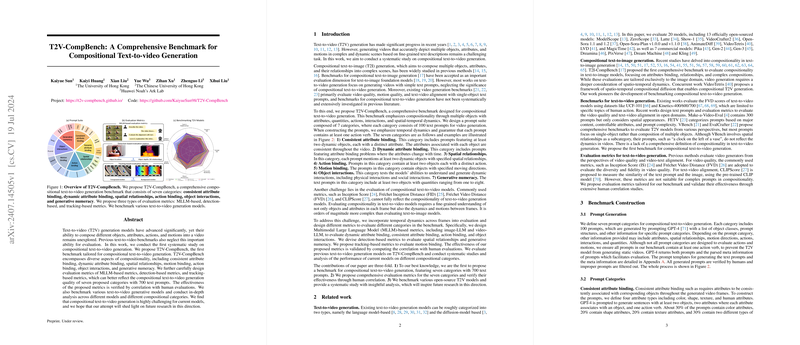An Overview of T2V-CompBench: A Comprehensive Benchmark for Compositional Text-to-Video Generation
The paper "T2V-CompBench: A Comprehensive Benchmark for Compositional Text-to-Video Generation" presents a novel evaluation framework explicitly designed to address the intricacies of compositional text-to-video (T2V) generation. This work fills a notable gap in the landscape of video generation research by constructing a benchmark that emphasizes compositionality, a dimension largely overlooked by existing benchmarks which usually focus on simpler aspects of video generation.
Key Contributions
- Benchmark Construction: The paper introduces T2V-CompBench, which rigorously tests the compositional abilities of T2V models across seven categories: consistent attribute binding, dynamic attribute binding, spatial relationships, action binding, motion binding, object interactions, and generative numeracy. Each category comprises 100 video generation prompts created using GPT-4, ensuring coverage of diverse and challenging scenarios.
- Evaluation Metrics: Recognizing the inadequacies of traditional metrics like Inception Score (IS) and Fréchet Video Distance (FVD) in compositional contexts, the authors propose three specialized metrics:
- MLLM-Based Metrics: Utilizing Multimodal LLMs (MLLMs) for nuanced understanding and scoring of dynamic attribute binding, consistent attribute binding, and action binding.
- Detection-Based Metrics: Leveraging object detection models to evaluate spatial relationships and generative numeracy.
- Tracking-Based Metrics: Utilizing tracking models to assess motion binding, focusing on the differentiation between object and camera motion.
- Extensive Benchmarking: The paper evaluates 20 T2V models, including 13 open-source and 7 commercial models. The results reveal that current models struggle significantly with challenges posed by compositional prompts, highlighting the need for further advancements in T2V generation.
Notable Findings
The research finds that commercial models generally outperform open-source ones across compositional categories, with certain models such as Dreamina and Gen-2 showing relatively better performance. However, none of the models consistently excel across all categories, underscoring the complexity and difficulty of compositional T2V generation. Particularly challenging categories include dynamic attribute binding and generative numeracy, where models often fail to accurately capture temporal changes or object quantities.
Implications and Future Directions
Practical Implications
The introduction of T2V-CompBench provides a comprehensive and rigorous framework for evaluating compositional T2V models, facilitating benchmarking and guiding research in developing more sophisticated generative models. The diverse categories ensure that models are evaluated on a variety of scenarios, pushing the boundaries of current capabilities in video generation.
Theoretical Implications
The findings suggest fundamental limitations in existing T2V models, especially in handling complex, dynamic, and multi-object scenes. This calls for a deeper integration of temporal and spatial understanding within generative frameworks and might necessitate novel architectures that can better grasp and generate compositional content.
Speculation on Future Developments
Future developments in AI for T2V generation may include:
- Advanced Temporal Models: Enhanced temporal modeling to capture dynamic attribute changes with greater fidelity.
- Multimodal Reasoning: Improved multimodal reasoning abilities in models, enabling better understanding and generation of compositional relationships.
- Integrative Frameworks: Development of unified frameworks that can simultaneously address spatial, temporal, and relational aspects in video generation.
Given the findings and the comprehensive nature of the proposed benchmark, T2V-CompBench is poised to be a critical tool for driving the next generation of improvements in text-to-video generative models. The benchmark's impact will likely extend beyond mere evaluation, influencing the design and training of future models in this evolving field.
